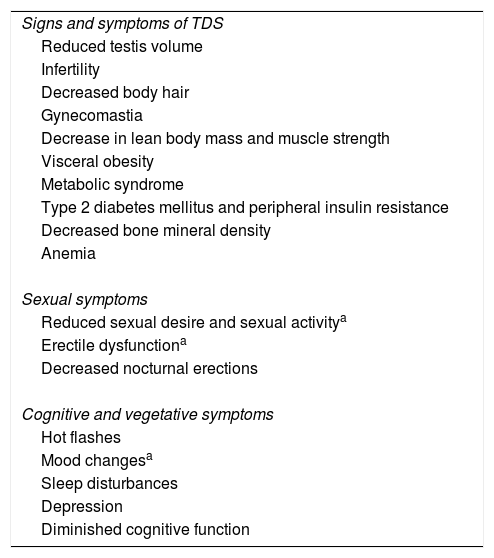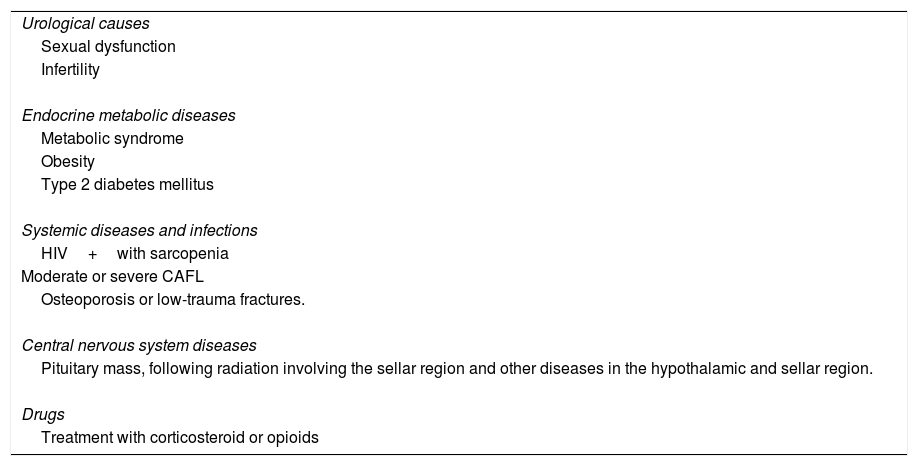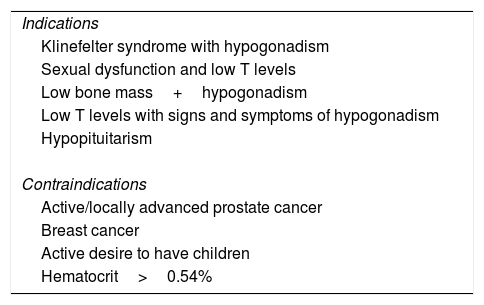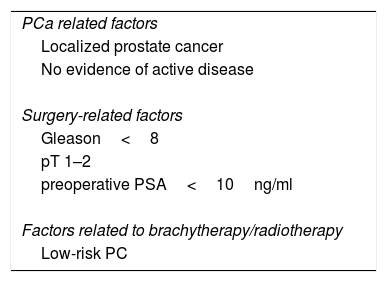The testosterone deficiency syndrome (TDS) is a very common clinical and biochemical condition that affects approximately 2–5% men over the age of 40. From a clinical point of view, it is usually associated with decreased sexual desire and activity, erectile dysfunction, low energy and mood swings, along with T<8–12nmol/l levels. Questionnaires are not useful in screening but may be useful for diagnosis and follow-up.
Its diagnosis requires the presentation of multiple hypogonadism symptoms together with two morning T tests below the acceptable limits. LH and SHBG levels can be useful to determine the cause and the free T level, respectively.
Contraindications for treatment are active prostate cancer, stage IV heart failure, breast cancer, desired fertility and hematocrit values over 54%.
Treatment is based on the cause of TDS, if any, along with testosterone supplementation. The objective is to achieve normal testosterone levels. Follow-up includes clinical history, analysis (PSA, T+SHBG, hematocrit, glucose and lipid profile) and rectal examination, 3, 6 and 12 months after beginning treatment.
El síndrome de déficit de testosterona (SDT) es una entidad clínica y bioquímica muy común, que afecta aproximadamente al 2-5% de los varones a partir de los 40 años. Desde un punto de vista clínico asocia más comúnmente disminución del deseo y actividad sexual, disfunción eréctil, disminución de la energía y cambios en el estado de ánimo, junto con unos niveles de testosterona (T)<8-12nmol/l. Los cuestionarios no son de utilidad en el screening, pero pueden serlo en el diagnóstico y en el seguimiento.
Para el diagnóstico es necesario que existan preferiblemente múltiples síntomas de hipogonadismo junto con 2 determinaciones matutinas de T por debajo del límite de normalidad de referencia del laboratorio. La determinación de la LH y la SHBG puede ayudarnos en el diagnóstico a la hora de determinar la causa y el nivel de T libre, respectivamente.
Las contraindicaciones para el tratamiento son el cáncer de próstata activo, la insuficiencia cardiaca grado IV, el cáncer de mama, el deseo genésico y la presencia de hematocrito >54%.
El tratamiento se basa en la modificación de la causa del SDT, si existe, junto con la suplementación de T. El objetivo es conseguir niveles de T en el rango medio fisiológico de normalidad. El seguimiento se realiza mediante historia clínica, analítica (PSA, T+SHBG, hematocrito, glucosa y perfil lípídico) y tacto rectal, a los 3, 6 y 12 meses de iniciar el tratamiento.










